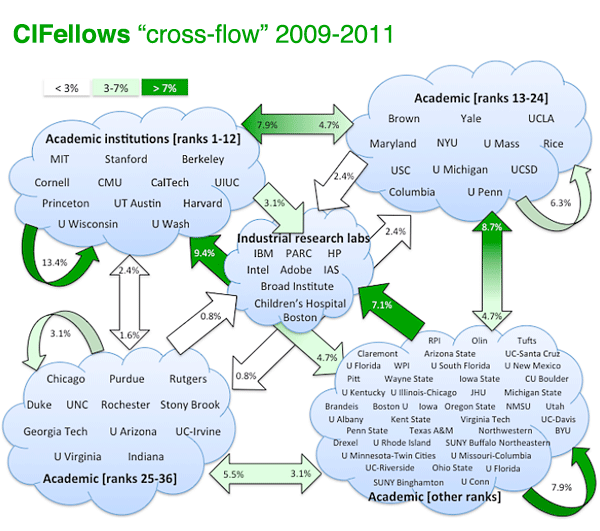Diversity
The CIFellows Project was designed to determine a set of awards that was diverse along many dimensions. In addition to conventional diversity objectives, reviewers sought to balance awards among the sub-disciplines of the field. A unique component of the selection process was a so-called “max-two rule,” which mandated that no more than two awardees could come from a single Ph.D.-granting college or university and no more than two awardees could go to a single host organization. The first part imparted some fairness among applicants; the second part infused “new blood” in institutions unable to hire new faculty because of economic conditions. An additional intent was to ensure “cross-flow” across institutional types, with the hope of establishing long-term collaborations among diverse institutions. (Indeed, it often happened in the selection process that a third, fourth, or fifth candidate from university X or going to organization Y would be encountered, causing reconsideration of the decisions made earlier in the review process. As a consequence, most of the finalists were discussed multiple times by the review committee throughout the process.) The impact was not surprising: many applicants wanted to go to top-ranked institutions (and came from larger programs), and thus ran into exceptionally stiff competition.

A result of the max-two rule described above, was that the 60 awardees in 2009 came from 44 different academic institutions and went to 45 different host organizations. Similar numbers were observed in 2010 and 2011. The figure above illustrates the “cross-flow” achieved in the full set of 127 awards.
We measure “cross-flow” by classifying institutions sending (i.e., graduating) and receiving (i.e., hosting) CIFellows according to the groupings of CRA´s annual Taulbee Survey, which are derived from the National Research Council´s (NRC´s) 1994 rankings of computer science doctoral programs: departments ranked 1-12, 13-24, 25-36, and higher than 36 or unranked (“other ranks”). This grouping approach is admittedly imperfect; the ratings are outdated and apply only to a given institution´s computer science program, even though CIFellows or mentors may be from computer engineering, information systems, or other allied programs. However, it serves the purpose of an approximate measure of institutional peers. The diagram shows the distribution of CIFellows who flow along each possible pathway between the five institution groups, from their degree-granting institution to their host institution. The five groups pictured are the four academic groups plus one for industry. The institutions in each group are listed on the appropriate “cloud.” The groups with NRC ranking numbers include all schools within that group, regardless of whether they participated in the CIFellows Project; the “other ranks” and industry groups list only those institutions that have participated in the program to date. The numbers are percentages of the 127 CIFellows who followed the corresponding path. On the double-headed arrows, the numbers at each end are the percentages of CIFellows going to that group from the other. Arrows that exit and enter the same group represent the percentages of CIFellows remaining in the same group but moving to a host location different from their degree-granting institution.






